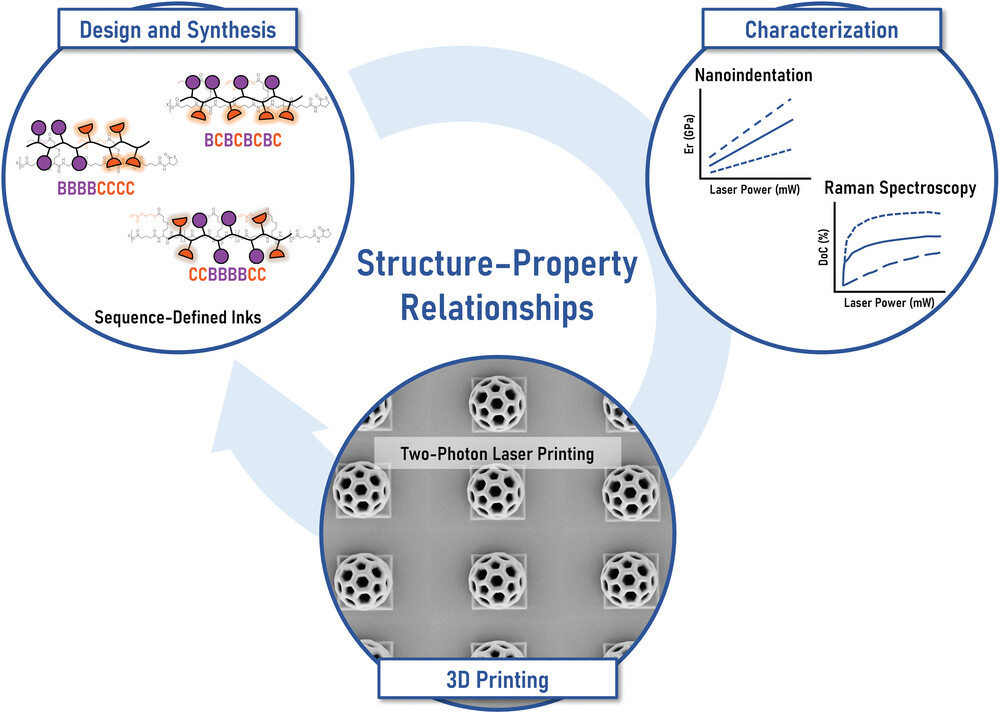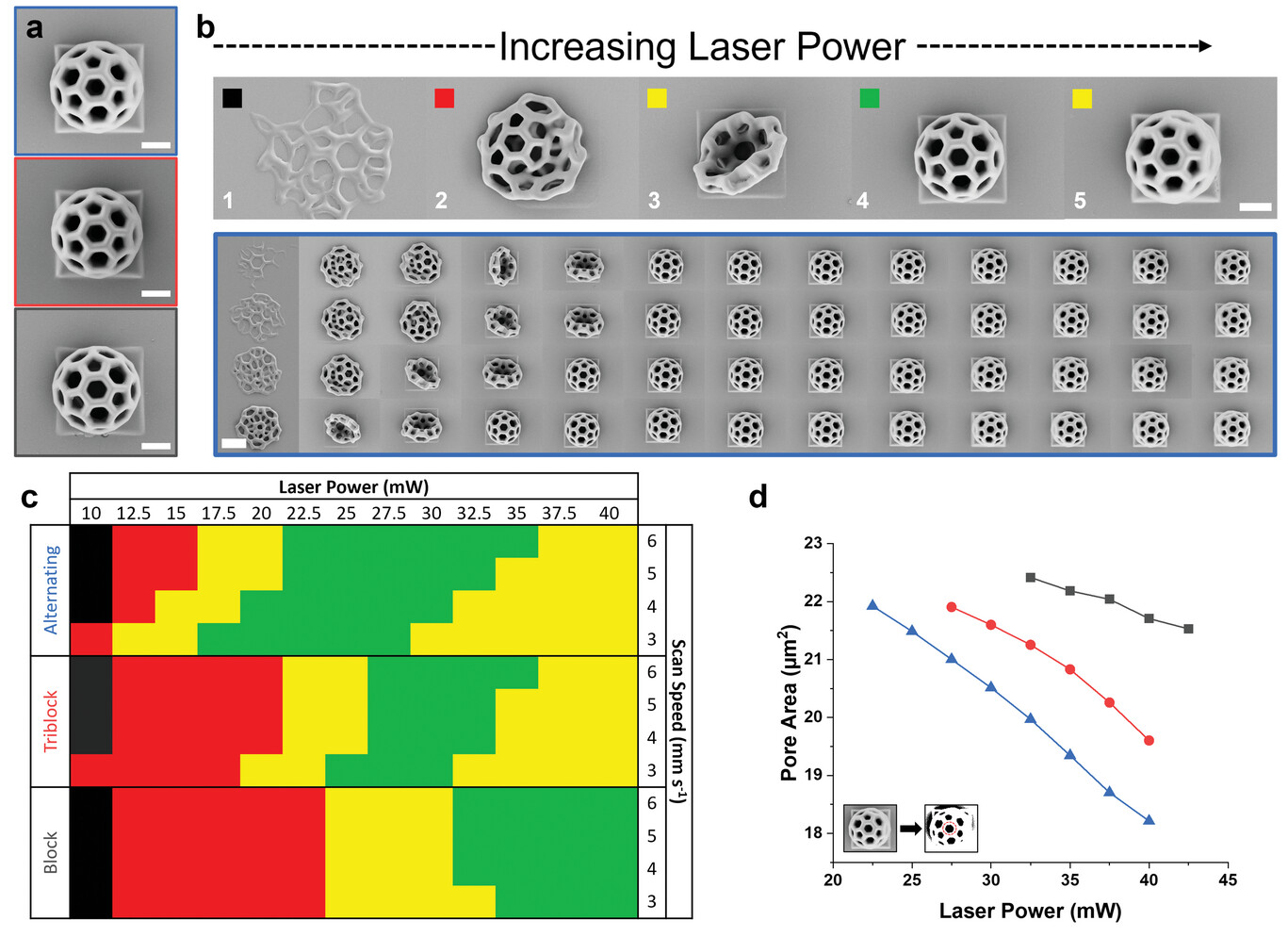| Dec 15, 2023 |
Molecular design unlocks precision-engineered materials for revolutionary 3D printing
|
|
(Nanowerk News) Nature boasts an unparalleled talent for material fabrication through precise molecular architecture - the intricate protein machines that drive metabolism and replication reveal Assembly lines fine-tuned over eons of evolution. Despite remarkable advances, chemists still struggle to approach the precision and complexity of even the humblest biomolecule. However, recent breakthroughs inch closer toward custom-engineering synthetic materials from the molecular up.
|
|
New polymerization methods afford unprecedented control to dictate properties through designed sequences along polymer backbones - yet applications of such Sequence-defined macromolecules remain confined to niche domains like data encryption.
|
|
New research, published in Small ("Macromolecular Engineering: From Precise Macromolecular Inks to 3D Printed Microstructures"), pioneers sequence control into a transformative manufacturing paradigm - additive 3D microprinting.
|
 |
| Overview and relationship of the steps explored in the following work: design and synthesis of the three crosslinkable oligomers with controlled monomer sequence, 2PLP of 3D microstructures from the formulated inks, chemical and mechanical characterization of the 3D microstructures, and the relationships from macromolecular control to printed microstructures. (Reprinted with permission from Wiley-VCH Verlag)
|
|
Through rational molecular design, the research team from Heidelberg University and the Max Planck Institute for Medical Research, direct sequence-defined materials as 3D printable inks, programming print resolution, mechanics and fabrication limits from monomer positioning along the primary structure. Such molecular mastery unlocks vast potential for 3D constructing specialized devices, from targeted drug delivery vehicles to labeled cell growth scaffolding or even molecular circuit components. As nature has shown, sequence encodes function.
|
|
This new research bridges sequence-defined macromolecules with 3D microprinting to pioneer a new generation of intricately structured materials.
|
|
Two-photon laser printing (2PLP) enables fabrication of micro-scale 3D structures like micro-optics or microrobotics. However, conventional acrylate inks lack molecular definition. This research investigates manipulates macromolecular sequence to systematically alter 3D printability and properties.
|
|
The researchers synthesized three unique eight-unit oligomers with identical composition but varied positioning of photocross-linkable and non-functional units. The oligomers contained either alternating crosslinkable/non-functional groups, a crosslinkable triblock motif bracketed by non-functional units, or a non-functional block bracketing crosslinkable groups.
|
|
After formulating inks, the team 3D printed intricate “buckyball” structures, analyzing print resolution across varied laser parameters. Surprisingly, the alternating oligomer afforded the widest printing window before defects occurred, requiring the lowest light intensity yet reaching the highest mechanical integrity of the three inks.
|
 |
| a) 2PLP printed 3D buckyball structures using alternating (blue), triblock (red), and block (gray) oligomer inks (laser power = 32.5 mW, scan speed 5 mm s−1), b) SEM images of the printability study at increasing laser powers for alternating ink, from 10 mW to 40 mW (left to right) and from 3 to 6 mm s−1 (bottom to top). c) Printability of the three oligomer inks over laser power range 10–40 mW and scan speeds of 3–6 mm s−1. d) Analysis of decreasing area of the central pore with increasing laser power, after converting the microscope images to binary. Insert of (d) shows representative SEM image (left) and binary image (right) with the analyzed area highlighted in red. Scale = 8 µm. (Reprinted with permission from Wiley-VCH Verlag)
|
|
Through spectroscopic monitoring during printing, the researchers traced enhanced performance to differences in crosslinking kinetics and network topology dictated by sequence. Crosslink positioning changed local reaction rates and opportunities. Block positioning concentrated reactive groups, driving rapid conversion yet low mechanical properties, potentially from intramolecular loops leaving dangling chains. Alternating placement dispersed groups for gradual homogeneous network formation without defects, maximizing mechanics. Triblock printing fell intermediate.
|
|
Varying crosslink proximity also altered requirements for print stability. The block oligomer, despite highest conversion, needed far higher light intensities to print without collapsing, hinting localized weakness from uneven topology. Sequence can directly program print performance through programmed network development.
|
|
With exquisite sequence-based control to dictate print behaviors, the researchers then demonstrated microprinting intricately structured birds, mammals and plants across the three inks. The alternating oligomer achieved the finest resolution and overhangs. Recently developed photoinitiators promise even greater capacities.
|
 |
| Representative SEM images of 3D microstructures printed with 2PLP with alternating (blue), triblock (red), and block (gray) oligomer inks printed with 0.25 wt.% DETC demonstrating versatility of the oligomers as inks for 3D microprinting. Scale = 10 µm. (Reprinted with permission from Wiley-VCH Verlag)
|
|
This pioneering research illuminates how sequence-defined molecular engineering can unlock immense potentials for 3D printing customized materials. Simply by manipulating the positioning of photocrosslinkable units along an oligomer backbone, the researchers programmed dramatic differences in print resolution, fabrication windows, mechanics and topology of finalized prints. The study provides a framework and molecular-level understanding to translate precision synthesis into 3D prints rivaling biological builds.
|
|
The doors now opened to custom-tailor 3D printable inks through sequence design are vast and intriguing. Beyond dialing mechanical strength, flexibility and dynamics via monomer positioning, one could also engineer specialized prints from the molecular up - drug-releasing vessels with encoded release kinetics, growth factors to spur directed cell migration, conductive stacks for recording neuronal signals or labeled scaffolding to study stem cell forces during division.
|
|
Such precise and multi-functional 3D printed architectures could accelerate device fabrication from prosthetics to lab-on-a-chip and bio-integrated electronics. Just as nature’s proteins achieve wondrous diversity and precision of function through programmed sequencing of amino acids, this breakthrough promises a new era where human-designed sequencing of macromolecules may finally approach such wonders.
|



